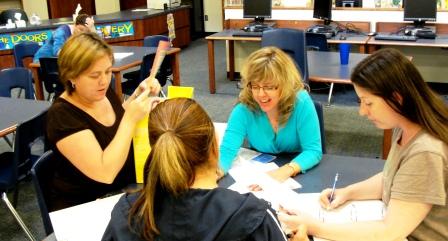Average & Rest
Average (adjective): having qualities that are seen as typical; mediocre; not very good
AVERAGE: My first year teaching in Prince George’s County, Maryland was an enlightening experience. As I fervently interviewed with the last administrator who had an opening, he suggested that I “be prepared to teach average or below-average students because that’s what they had in their school.” I was speechless. I couldn’t believe he had just said that to a prospective teacher. I was also “speechless” because I needed the job and he gave the final say in my being hired.
I did get the job and I spent the next three years doing my very best to prove him wrong. Actually, it was my students who proved him wrong. Every single one of my students was amazing, intelligent, sensitive, special, and unique. I would never use the word average to describe any of them. However, the school district did use that adjective quite a bit when referring to students who were not classified as “gifted” or “at-risk.” Every time they used the term “average” it made me dig in deeper to prove them wrong.
Michael Thompson, clinical psychologist and author, says these average students tend to fall through the cracks. They are known as “woodwork” children because they are typically quiet, biddable, and good students. Their only fault is that they don’t stand out from the crowd. A school district typically spends less that 35% of their budgets on the average learner. After all, they don’t “need” any special attention. I found that all of my students were “at-risk” when they didn’t get what they needed and what they deserved.
I have found that adults are the same way. They, too, are amazing, intelligent, sensitive, special, and unique. Adults also blossom when treated as extraordinary.

Have you ever been called average? Have you ever been treated as if you were average? How did that make you feel? How did you react?
Now, think about the times that you were treated with class and dignity; times when you were given priority. Did you feel special? Did you act differently because you were treated that way? Knowing this, how will you respond to the people around you… none of whom are average…

REST: One of my Granny’s favorite mantras was, “Your best offense is to rest.” As a child this seemed like punishment. As a mother of preschoolers, it was often impossible–even at night. As a mother of teenagers and working a full-time job, I need rest more than I did when they were toddlers, but when and how?
Sara Mednick, who wrote the book Take a Nap! Change Your Life, has some helpful hints:
1. The first consideration is psychological: Recognize that you’re not being lazy; napping will make you more productive and more alert after you wake up.
2. Try to nap in the morning or just after lunch; human circadian rhythms make late afternoons a more likely time to fall into deep (slow-wave) sleep, which will leave you groggy.
3. Avoid consuming large quantities of caffeine as well as foods that are heavy in fat and sugar, which meddle with a person’s ability to fall asleep.
4. Instead, in the hour or two before your nap time, eat foods high in calcium and protein, which promote sleep.
5. Find a clean, quiet place where passersby and phones won’t disturb you.
6. Try to darken your nap zone, or wear an eyeshade. Darkness stimulates melatonin, the sleep-inducing hormone.
7. Remember that body temperature drops when you fall asleep. Raise the room temperature or use a blanket.
8. Once you are relaxed and in position to fall asleep, set your alarm for the desired duration.
Want to Dive in Deeper?
• What it Means to Be Average: The Twisted Standards for Quantifying an Individual’s Value
• 9 Valuable Principles That Will Make You Treat People Better
• Experience Teen Drama Overload? Blame Biology
• Why You Should Take a 10-Minute Nap Every Day
• How to Power Nap for All Day Energy
My favorite illustration of rest comes from Henry Drummond:
Two painters were once asked to paint a picture illustrating his own idea of rest. The first chose a quiet, lonely lake, nestled among mountains far away. The second, using swift, broad strokes on his canvas, painted a thundering waterfall. Beneath the falls grew a fragile birch tree, bending over the foam. On its branches, nearly wet with the spray from the falls, sat a robin on its nest.
The first painting was simply a picture of stagnation and inactivity. The second, however, depicted rest.
May you find your place of rest in the crevasse of whatever thundering waterfall life may bring this week!
As always, I believe in you and what is possible when you believe in others. Quite frankly, I know you’re AMAZING!
–Glenna
Glenna,
After receiving this Two for Tuesday, Dr. J. Medgar Roberts, a Teacher Specialist from Kennemer Middle School in Duncanville ISD sent me this…I was touched by his response and knew it should be a part of this MOTIVATION & INSPIRATION post.
I’ve spent most of my career advocating for “average” students. We do a disservice to young teachers giving them either difficult classes or “average” classes, using the justification that since they are new they need easier classes. The truth is that veteran teachers get the “good” classes, choosing to teach the Pre-AP and gifted classes and leaving the other classes for teachers who don’t have the seniority to have a voice. That path isn’t always in the best interest of kids.
As administrators learned that I was a “good” teacher—whatever that means—I was encouraged to teach Pre-AP or even AP classes. I always refused. My feeling was that those kids didn’t really need me. They had plenty of advocates and fans—teachers and administrators who would teach them, love them, and fight for them. They had a lot of people in their corner, classified as “good” teachers, that were more than happy to have those classes. Additionally, there was seldom a question of whether those kids could learn. I don’t mean to say those teachers aren’t good at what they do. There was no way to stop them from learning almost no matter who the teacher was. The question was usually what they would learn and how fast, not whether.
“Average” kids, on the other hand, always had that question mark above their heads. There were people who had questions about whether they could learn or whether they would learn. They needed better examples of teaching and learning, people who believed in them, and teachers who weren’t afraid that their test scores wouldn’t be high enough to get in there and maximize their potential. Those kids need good teachers, too.
As my career advanced and my “average” kids surpassed the expectations of many of those Pre-AP classes, people tried to dismiss their success by saying it was the kids. That somehow I’d found the magic bullet to get the counseling staff to only assign me the “good” kids even though my course description was for the “average” kids. They missed the truth.
The truth is that every single kid I was assigned was special, just like every kid they were assigned. The difference is that I took the time to find out who my kids were and what made them special. Their gifts may not have been academic, but when I found their giftedness I also often found the key to their academic gifts as well. You are correct: in the right environment every kid has an intelligence, a sensitivity, a uniqueness, and an amazing little kernel of humanity that blossomed when properly nourished.
I am fortunate to have never been called average. In fact, I credit that fact as being the reason why I have always felt special and gifted. There is nothing special about me except that I have always been made to believe I am special. It is my goal as an educator to share that feeling with every students with whom I interact. Everyone deserves to have their gifts discovered and lauded by people they respect. The content will come if the recognition comes first.
Thank you for sharing! I always enjoy reading your reflections.
Medgar

